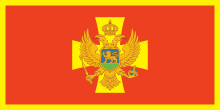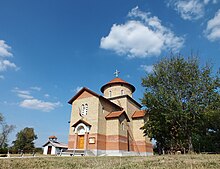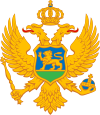| Црногорци у Србији Crnogorci u Srbiji | |
|---|---|
 Flag of the National Council of the Montenegrin minority in Serbia Flag of the National Council of the Montenegrin minority in Serbia | |
| Total population | |
| 20,238 Serbian citizens, 0.30% of Serbia's population (2022) | |
| Regions with significant populations | |
| 12,424 (0.71%) | |
| 5,134 (0.31%) | |
| Languages | |
| Serbian, Montenegrin | |
| Religion | |
| Serbian Orthodox | |
| Related ethnic groups | |
| Serbs, South Slavs | |
Montenegrins of Serbia (Serbian and Montenegrin: Црногорци у Србији, romanized: Crnogorci u Srbiji) are a recognized national minority in Serbia. According to the 2022 census, the population of ethnic Montenegrins in Serbia is 20,238, constituting 0.3% of the total population. The vast majority of them live in Vojvodina and Belgrade.
Geography
The largest concentration of Montenegrins in Vojvodina can be found in the municipalities of Mali Iđoš (12.28%), Vrbas (11.65%) and Kula (5.60%). Settlements in Vojvodina with an absolute or relative Montenegrin majority are: Lovćenac in the Mali Iđoš municipality with 56.86% Montenegrins, Kruščić in the Kula municipality with 32.64%, and Savino Selo in the Vrbas municipality with 38.20% Montenegrins. Formerly, the village of Bačko Dobro Polje in the Vrbas municipality also had a Montenegrin majority (According to the 1971 census, Montenegrins comprised 55.39% of the population of this village, while according to the 2002 census, the current population of the village is composed of 57.17% Serbs and 38.18% Montenegrins. Also, Montenegrins in Sivac in the Kula municipality had a Montenegrin majority in the 1970's. Now they have a sizable minority population of 30.06%, according to the 2002 census.
Demographics

| Part of a series on |
| Montenegrins |
|---|
 |
| By region or country |
| Recognized populations |
|
Montenegro Serbia Bosnia and Herzegovina Croatia North Macedonia Kosovo Albania |
| Diaspora |
|
|
|
|
| Culture |
|
| Religion |
|
Eastern Orthodox Catholicism Islam |
| Language and dialects |
| History |
|
History of Montenegro Rulers |
| Year (census data) |
Number of Montenegrins | Percent of the national population |
|---|---|---|
| 1948 | 74,860 | 1.15% |
| 1953 | 86,061 | 1.23% |
| 1961 | 104,753 | 1.37% |
| 1971 | 125,260 | 1.48% |
| 1981 | 147,466 | 1.58% |
| 1991 | 118,934 | 1.52% |
| 2002 | 69,049 | 0.92% |
| 2011 | 38,527 | 0.54% |
| 2022 | 20,238 | 0.30% |
In Vojvodina, the number of Montenegrins, according to 1948-2011 censuses: 1948: 30,589 (1.9%); 1953: 30,516 (1.8%); 1961: 34,782 (1.9%); 1971: 36,416 (1.9%); 1981: 43,304 (2.1%); 1991: 47,289 (2.3%); 2002: 35,513 (1.75%); 2011: 22,141 (1.15%).
Culture
Montenegrins in Serbia speak Serbian/Montenegrin, and the vast majority are adherents of the Serbian Orthodox Church. The society of Montenegrins in Serbia, known as "Krstaš", is based in Lovćenac. The Montenegrin language was recognised as a minority language in official use in Mali Iđoš.
Notable people
- Mihailo Janketić, actor
- Nenad Stevović, politician, publicist, political scientist and a researcher
See also
- Serbia-Montenegro relations
- Serbs of Montenegro
- Serbia and Montenegro
- Serbian-Montenegrin unionism
- Ethnic groups of Vojvodina
- Montenegrin Party
Sources
- "Final results - Ethnicity". Почетна. 2023-07-14. Retrieved 2023-12-07.
- ^ "Population by ethnicity, by areas" (PDF). Retrieved 2023-12-07.
- "Nacionalni savjet crnogorske nacionalne manjine".
- B92: Crnogorski jezik u Malom Iđošu (Montenegrin language in Mali Iđoš) (in Serbian)
- Serbia, RTS, Radio televizija Srbije, Radio Television of. "Miša Janketić – njegovi domovi bili su kuća i bina". www.rts.rs. Retrieved 2022-02-01.
{{cite web}}: CS1 maint: multiple names: authors list (link)
External links
| Montenegrin diaspora | ||
|---|---|---|
| Europe |  | |
| Elsewhere | ||
| Ethnic groups in Serbia | |
|---|---|
| Serbs (Vojvodina, Kosovo) | |
| Larger ethnic minorities | |
| Smaller ethnic minorities | |
| |